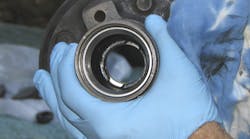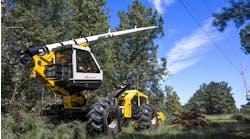Whether it’s being used to lubricate an application, seal something in order to keep out contamination or protect against corrosion, grease comes in handy for technicians trying to conduct proper and effective maintenance on their fleets.
All greases are composed of lubricating oil, which consists of base oils and additives, and a thickener, typically a chemical soap. It is often utilized on components where the lubricant does not seal well, including wheel bearings, universal joints, tie rod ends, ball joints and fifth wheels on trucks and trailers, explains Chris Barker, manager, tech services department, Royal Purple, a manufacturer of lubricants for automotive and other applications (www.royalpurpleconsumer.com). The grease’s thickener serves to keep the lubricating oil from leaking from the component, and it also acts as an effective barrier to unwanted contaminants such as water and particulates.
“The lubricating oil in the grease is what actually performs the job of providing wear protection and lubricity, while the thickener acts as a sponge to hold the lubricating oil in place,” he says.
GREASE DEFINED
Grease is primarily defined by three key criteria:
- Viscosity grade.
- NLGI (National Lubricating Grease Institute) grade.
- Type of thickener used.
“Viscosity grade refers only to the lubricating oil and is similar to the SAE viscosity grades seen on bottle labels of automotive oils, 15W-40, 75W-90, etc.,” explains Royal Purple’s Barker. “Grease viscosity grades are commonly expressed in the ISO viscosity grade scale, rather than the SAE scale.”
Commonly used automotive greases generally fall within a certain viscosity grade range that is useful in temperate climates, so the viscosity grade is not specified, he adds.
A grease’s NLGI grade refers to its softness or firmness. Greases with a high consistency (stiff greases) are assigned high NLGI grades. Those with low consistency (soft greases) are designated with low NLGI grades.
According to Barker, a NLGI grade spans from 000 (the softest; essentially a fluid) to 6 (the firmest; similar to clay). The vast majority of vehicular grease applications merely specify the use of a NLGI #2 EP (extreme pressure) or multi-purpose grease.
“The thickener of the grease determines chemical compatibility between different greases and not all of the chemical soaps are compatible,” he points out.
At times, a more liquid material is used in well-sealed applications like engines, because it is well-suited at lubricating moving components and managing byproducts of combustion and contaminants, says Mark Nyholm, technical product manager - heavy duty, Amsoil, a provider of synthetic lubricants, fuel additives and filtration products (www.amsoil.com).
KEY CONSIDERATIONS
For one reason or another, maintenance facilities may opt to change the brand of grease they use for various applications. When this decision is made, it is important for maintenance personnel to take a few extra steps to ensure unwanted complications don’t arise as a result of the switch.
Royal Purple’s Barker advises maintenance personnel to clean out the old grease and perform a thorough purge. “This ensures there are no compatibility issues between the new and old grease,” he says.
The selection of the replacement grease for various applications also must be a well-thought-out process. For example, when greasing bearings, size, shaft speed and operating temperature are all factors in determining what grease will provide the best performance.
“When two components need lubrication, the grease is squeezed a little, and the thickener releases a little base oil to lubricate the application,” says Amsoil’s Nyholm. “The thickener absorbs back that base oil. Think of grease like a sponge that releases and absorbs base oil constantly.”
CONVENTIONAL VERSUS SYNTHETIC
Conventional greases and synthetic greases differ in the type of base oil used in the lubricating oil found in the product. Certain manufacturers of grease employ conventional base oils. Others, including Royal Purple, opt for synthetic base oils.
Fleet maintenance facilities should strongly consider why they opt for one over the other. Is it the life cycle value of the grease? Is it part of an overall purchasing plan? Whatever the case may be, it is critical to revisit the question from time to time. Understanding lubricant flow rates when making the transition from conventional grease to a synthetic offering also helps ensure desired results.
When two different types of grease are mixed together, the end result could be something with a softer makeup than either of its component greases, which could lead to lubricant failure. As a result, it is not wise to mix greases, especially those with different thickeners.
“Grease thickeners are almost all man-made and, therefore, synthetic,” Royal Purple’s Barker adds.
“When comparing a conventional oil-based grease to a synthetic oil-based grease, there is much more to compare than just base oil,” says Amsoil’s Nyholm. “Yes, the obvious difference is base oil. The quality of that base oil matters when it comes to performance.
“The finished formula and its manufacturing also make up a substantial aspect to the overall quality of the grease product,” he adds.




